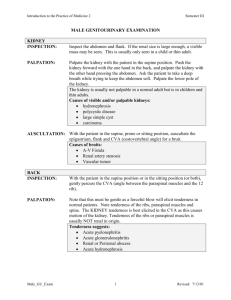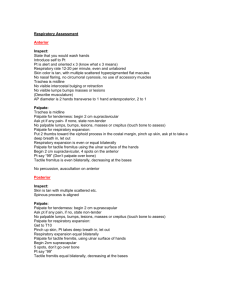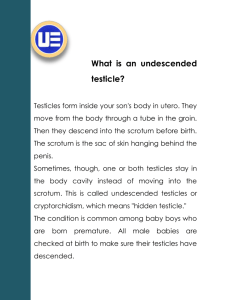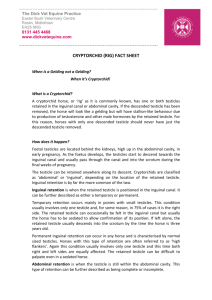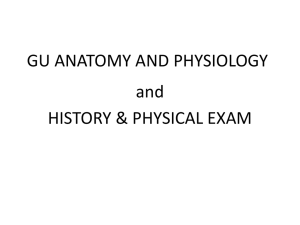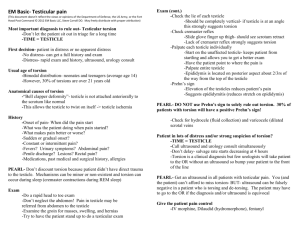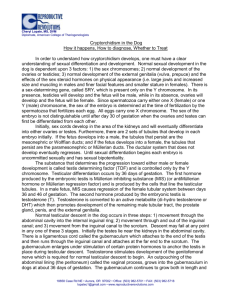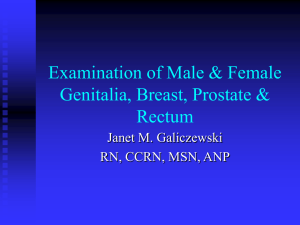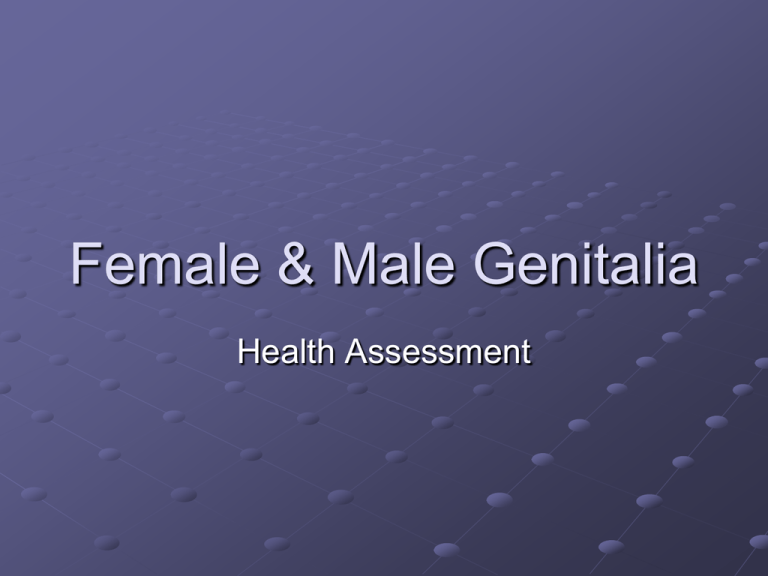
Female & Male Genitalia
Health Assessment
Female Health History
Menstrual History
Age at menarche, frequency & duration of
menstrual cycle, character or flow (amount and
presence of clots), presence of dysmenorrhea
(painful menstruation), dates of last two
menstrual periods and premenstrual symptoms.
Bleeding outside of period or during menopause
Ie. Endometriosis, endometrial cancer
Obstetric History
Number of pregnancies, miscarriages or
abortions, or complications
Female Health History
Received human papillomavirus (HPV) vaccine
Prevent against cervical cancer & genital warts
Symptoms of infection/STIs
Vaginal discharge, pelvic pain, swollen perianal
tissues or genital lesions
Symptoms of genitourinary problems
Burning during urination (dysuria), frequency,
urgency, nocturia, hematuria, incontinence, stress
incontenence
Symptoms of Perimenopause
Hot flash, drenching sweats, mood swings, vaginal
dryness, itching, numbness and tingling, headache, or
palpitations.
Female Health History
Risk factors for ovarian cancer
>40 y/o, obese, history of ovarian dysfunction, breast or
endometrial cancer, irradiation of pelvic organs,
endometriosis, infertility or nulliparity, use of estrogen
only hormone replacement
family history of ovarian, breast, or endometrial cancer
Risk factors for endometrial cancer
Postmenopausal, obese, infertile, early menarche, late
menopause, HTN, DM, gallbladder disease, PCOS,
estrogen-related exposure (HRT or tamoxifen use)
Family history of endometrial, breast, or colon cancer
Both Genders- Health History
Sexual history and
current/past contraceptive
practices
Oral contraceptives- Ask
about tobacco use, history of
blood clots due to increased
risk for blood clots.
Previous illness or surgery
involving reproductive
organs, including STIs
Male Health History
Urinary symptoms
Frequency, nocturia, urgency, decreased urinary
output, difficulty starting stream, hematuria
Penile pain or swelling, genital lesions or urethral
discharge
Heaviness or painless enlargement of testis or
irregular lumps
Performance of self testicular exam?
Presence of inguinal hernia
Difficulty achieving erection or ejaculation
Examination Tips
Explain each step of the examination in advance
Offer a chaperone
Keep patient draped for privacy
Avoid unexpected or sudden movements
Watch patient’s face to monitor comfort
Wear gloves
Female Exam
Inspection
Skin color
No suspicious pigmented
lesions noted.
Hair distribution
Inverted triangle. No nits or
lice.
Tanner staging for
adolescence
Note: The nurse will often examine external
genitalia while performing routine hygiene
measures or preparing to insert a urinary
catheter
Inspection
Labia majora
Symmetrical,
no
excoriation,
nodules, rash,
lesions or
edema
Perineum
Smooth
Well healed
episiotomy
scar
Female Abnormalities
Inspection
With gloved hand
separate labia major
and inspect:
Clitoris
Labia minora
Dark pink and moist
Urethral opening
Slitlike and midline
Vaginal opening
No discharge or foul
odor
No excoriation, nodules,
rash, lesions, or edema.
Discharge
Candidiasis- thick, white
curdy
BV- thin, creamy graywhite; foul smelling
Trichomoniasis- frothy
yellow-green; foul
smelling
Chlamydia- White
mucopurulent
Gonorrhea- yellowish
Female Abnormalities
Female Abnormalities
Rectocele
Cystocele
Uterine prolapse
Speculum Examination
For routine pelvic exams patient should not
be on menses
Patient should avoid intercourse, douching, vaginal
suppositories and tampons 24 hours prior to exam
Have patient empty bladder before examination
Patient lies supine, with head and shoulders elevated
Have patient place heels in stir-ups, slide all the way
down examination table until buttocks extend slightly
beyond the edge
Thighs should be flexed, abducted and externally rotated
at the hips
Have light source available and supplies accessible
Speculum Examination/Bimanual
Palpation
Obtain cervical smears and cultures
Pap Smears for cervical cancer
Inspect vaginal wall and cervix
Palpate cervix, uterus & ovaries
Charting
Charting
Male Genitalia
Male Anatomy
Inspection- Tanner Stage
Inspection of Penis
Skin
Winkled, hairless,
without lesions or
inflammation
Dorsal vein may be
apparent
Inspection of Penis
Glans
Smooth, without
lesions
May need to retract
foreskin
Phimosis- unable to
retract foreskin
ParaphimosisUnable to return
foreskin to original
position
Smegma- Cheesy
substance under
foreskin
Inspection/Palpation of Penis
Urethral meatus
Positioned centrally
Hypospastic- ventral
location
Epispadias- dorsal
location
Compress glans
anteroposteriorly
between thumb and
forefinger to assess for
dc
Meatus pink, smooth,
without discharge
Profuse yellow = gonococcal
Scanty white = possible
Chlamydia
Palpation of Penis
Palpate shaft between
thumb and first 2 finger.
Assess for nodules,
induration, or tenderness
Smooth, semifirm, and
nontender
If man gets erection during
the exam, explain that it is a
normal response and finish
the exam
Inspection of Scrotum
Hold scrotum out of way
with back of hand
Mild asymmetry normal
Left often lower than right
Assess for edema and
lesions
Palpation of Scrotum
Palpate scrotum,
epididymis &
spermatic cord
between thumb and
first two fingers
Testes- freely
movable, oval, firm,
rubbery, smooth and
equal bilaterally.
Palpation of Scrotum
Epididymis- discrete,
smooth, and nontender
Spermatic cord- smooth
and nontender
Inspect for Hernia
Inspect inguinal region
for bulge as person
stands and strains
down.
No bulge noted
Palpation for Hernia
Gently insert finger
into canal and ask
patient to bear down.
No inguinal hernia
noted.
Palpate femoral areas
for bulge
No femoral hernia
noted.
Palpate Inguinal Lymph Nodes
Palpate inferior to
inguinal ligament
and along upper
inner thigh
Normal to palpate
isolated node on
occasion
Nonpalpable or
small (<1cm), soft,
discrete, and
movable.
Testicular Cancer
Incidence is low, 4 per 100,000
Peak age 15-35
If found early, excellent prognosis
The best time to examine testicles is during or
after a shower or bath. The warm water allows
the scrotum to relax and the testicles to drop
down. The left testicle normally hangs a bit lower
than the right. It is common for one testicle to be
larger than the other one.
Young men should examine themselves once a
month. More frequent exams actually may result
in missing a slowly changing lump.
Testicular Self Exam
Support each testicle with one hand and examine it with
the other.
Gently roll each testicle between the thumb and fingers.
Testicles should feel firm and smooth, about the
consistency of a hard-boiled egg without the shell.
The epididymis is a ropelike structure attached to the
back of the testis. This structure is not an abnormal lump
Feel for firm masses, lumps, or nodules in the testicle. In
cancer, these lumps often are painless.
Become familiar with normal size, shape, and weight of
each testicle and epididymis. This will help you
recognize a change from one self-examination to
another, if a change should occur.
Charting


